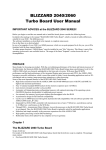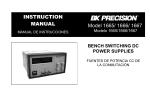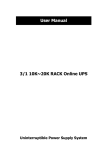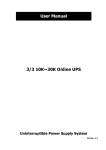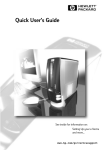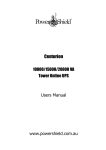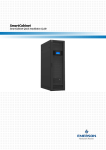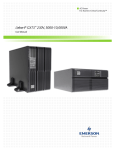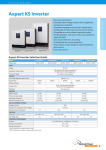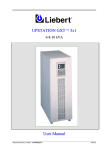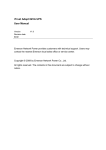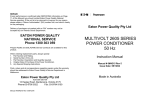Download I TABLE OF CONTENTS IMPORTANT SAFETY INSTRUCTIONS
Transcript
TABLE OF CONTENTS IMPORTANT SAFETY INSTRUCTIONS.................................................................... 1 SAVE THESE INSTRUCTIONS .......................................................................................................................1 1. ELECTROMAGNETIC COMPATIBILITY................................................................ 2 2. Introduction .................................................................................................... 3 3. System description .......................................................................................... 5 3.1 Transient Voltage Surge Suppression (TVSS) and EMI/FRI Filters .....................................................5 3.2 Rectifier/Power Factor Correction (PFC) Circuit.................................................................................5 3.3 Inverter..................................................................................................................................................5 3.4 Battery Charger ....................................................................................................................................6 3.5 DC-to-DC Converter..............................................................................................................................6 3.6 Battery ...................................................................................................................................................6 3.7 Dynamic Bypass ....................................................................................................................................6 4. Product Specification and Performance........................................................... 6 4.1 Model Description ................................................................................................................................6 4.2 Product Specification and Performance .............................................................................................7 5. Installation ...................................................................................................... 9 5.1 Unpacking and Inspection ...................................................................................................................9 5.2 Connect Input/Output Power..............................................................................................................9 5.3 Operating procedure for connecting the long backup time model UPS with the external battery .................................................................................................................................................................. 11 5.4 Parallel operation .............................................................................................................................. 12 I 6. Controls and Indicators ................................................................................. 16 7. Operation ...................................................................................................... 19 7.1 Operation Mode ................................................................................................................................ 19 7.2 Parallel Operation.............................................................................................................................. 20 8. Battery Maintenance..................................................................................... 20 9. Notes for Battery Disposal and Battery Replacement Procdures ................... 21 9.1 Battery Disposal................................................................................................................................. 21 9.2 Battery Replacement Procedures..................................................................................................... 21 10. Trouble Shooting ......................................................................................... 22 10.1 Checking UPS status ........................................................................................................................ 22 10.2 Adjust the factors caused the problem.......................................................................................... 22 Annex 1. Dry Contact ........................................................................................ 27 Remote EPO Input Port ............................................................................................................................27 Input Control Dry Contact Port ................................................................................................................27 Battery Low Alarm Output Dry Contact Port ......................................................................................... 28 General Alarm Dry Contact Port ............................................................................................................. 28 Utility Fail Alarm Dry Contact Port .................................................................................................. 29 II IMPORTANT SAFETY INSTRUCTIONS SAVE THESE INSTRUCTIONS This manual contains important safety instructions. Read all safety and operating instructions before operating the uninterruptible power systems (UPS). Adhere to all warnings on the unit and in this manual. Follow all operating and user instructions. This equipment can be operated by individuals without previous training. This products designed for commercial/industrial use only. It is intended for use with lift support and other designated “critical” devices. Maximum load must not exceed that shown on the UPS rating label. The UPS is designed for data processing equipment. If uncertain, consult your dealer or local representative. This UPS is designed for use on a properly grounded (earthed), 220/230/240VAC, 50 or 60Hz supply. The factory default setting is 220VAC/50Hz. Installation instructions and warning notices are in this manual. The HT11 06/10@220/230/240VAC is designed for use with a three-wire input (L,N,G). The HT31 10/15/20@220/230/240VAC is designed for use with a five-wire input (A,B,C,N,G). WARNING THE BATTERY CAN PRESENT A RISK OF ELECTRICAL SHOCK AND HIGH SHORT CIRCUIT CURRENT. FOLLOWING PRECAUTIONS SHOULD BE OBSERVED BEFORE REPLACING THE BATTERY. Wear rubber gloves and boots. Remove rings, watches and other metal objects. Use tools with insulated handles. Do not lay tools or other metal objects on the batteries. If the battery is damaged in any way or shows signs of leakage, contact your local representative immediately. Do not dispose of batteries in a fire. The batteries may explode. Handle, transport and recycle batteries in accordance with local representative. WARNING 1 ALTHOUGH THE HT11/31 HAS BEEN DESIGNED AND MANUFACTURED TO ENSURE PERSONAL SAFETY, IMPROPER USE CAN RESULT IN ELECTRICAL SHOCK OR FIRE. TO ENSURE SAFETY, OBSERVE THE FOLLOWING PRECAUTIONS: Turn off and unplug the HT11/31 before cleaning it. Clean the UPS with a dry cloth. Do not use liquid or aerosol cleaners. Never block or insert any objects into the ventilation holes or other openings of the UPS. Do not place the HT11/31 power cord where it might be damaged. 1. ELECTROMAGNETIC COMPATIBILITY * Safety IEC/EN 62040-1-1 * EMI Conducted Emission....................:IEC/EN 62040-2 Category C3 Radiated Emission.......................:IEC/EN 62040-2 Category C3 *EMS ESD............................................:IEC/EN 61000-4-2 Level 4 RS..............................................:IEC/EN 61000-4-3 Level 3 EFT.............................................:IEC/EN 61000-4-4 Level 4 SURGE.......................................:IEC/EN 61000-4-5 Level 4 Low Frequency Signals..............:IEC/EN 61000-2-2 Warning: This is a product for commercial and industrial application in the second environment-installation restrictions or additional measures may be needed to prevent disturbances. NOTICE This is a product for restricted sales distribution to informed partners. Installation restrictions or additional measures may be needed to prevent radio interference. Operated the UPS in an indoor enviroment only in an ambient temperature range of 0-40C(32-104F). Install it in a clean environment, free form moisture, flammable liquids, gases and corrosive substance. This UPS contains no user-serviceable parts except the internal battery pack. The UPS on/off push buttons do not electrically isolate internal parts. Under no circumstance attempt to gain access internally, due to the risk of electric shock or burn. Do not continue to use the UPS if the panel indications are not in accordance with these operating 2 instructions or the UPS performance alters in use. Refer all fault to your dealer. Servicing of batteries should be performed or supervised by personnel knowledgeable of batteries and the precautions. Keep unauthorized personnel away form the batteries. Proper disposal of batteries is required. Refer to your local laws and regulations for disposal requirement. DO NOT CONNECT equipment that could overload the UPS or demand DC current from the UPS, for example: electric drills, vacuum cleaners, laser printers, hair dryer or any appliance using half-wave rectification. Storing magnetic media on top of the UPS may result in data loss or corruption. Turn off and isolate the UPS before cleaning it. Use only a soft cloth, never liquid or aerosol cleaners. 2. Introduction Congratulations on your choice of the HT11/31 uninterruptible power supply(UPS), the HT11/31 comes in nominal power ratings of 6000VA,10000VA,15000VA and 20,000VA. It is designed to provide conditioned power to microcomputers and other sensitive electronic equipment. When it is generated, alternating current is clean and stable. However, during transmission and distribution it may be subject to voltage sags, spikes and complete power failure that may interrupt computer operations, cause data loss and even damage equipment. The HT11/31 protects equipment form these distrurbances. The HT11/31 is a compact, on-line UPS. An on-line UPS continuously conditions and regulates its output voltage, whether utility power is present or not. It supplies connected equipment with clean sinewave power. Sensitive electronic equipment operates best from sinewave power. For ease of use, the HT11/31 features a LCD display to indicate all information for UPS, and provide kinds of function buttons. 3 Fig 1. Front View of HT11/31 Series Fig 2. Rear View of HT11/31 Series 4 3. System description 3.1 Transient Voltage Surge Suppression (TVSS) and EMI/FRI Filters These UPS components provide surge protection and filter both electromagnetic interference (EMI) and radio frequency interference (RFI). They minimize any surge or interference present in the utility line and keep the sensitive equipment protected. 3.2 Rectifier/Power Factor Correction (PFC) Circuit In normal operation, the rectifier/power factor correction (PFC) circuit converts utility AC power to regulated DC power for use by the inverter while ensuring that the waveshape of the input current used by the UPS is near ideal. Extracting this sinewave input current achieves two objects: The utility power is used as efficiency as possible by the UPS. The amount of distortion reflected on the utility is reduced. This results in cleaner power being available to other devices in the building not being protected by the HT11/31. 3.3 Inverter In normal operation, the inverter utilize the DC output of the power factor correction circuit and inverters it into precise, regulated sinewave AC power. Upon a utility power failure, the inverter receives its required energy from the battery through the DC-to-DC converter. In both modes of 5 operation, the UPS inverter is on-line and continuously generating clean, precise, regulated AC output power. 3.4 Battery Charger The battery charger utilizes energy form the utility power and precisely regulates it to continuously float charge the batteries. The batteries are being charged whenever the HT11/31 is connected to utility power. 3.5 DC-to-DC Converter The DC-to-DC converter utilizes energy from the battery system and raises the DC voltage to the optimum operating voltage for the inverter. The converter includes boost circuit which is also used as PFC. 3.6 Battery The HT1106/HT1110 include value-regulated, nonspillable, lead acid batteries inside. To maintain battery design life, operate the UPS in an ambient temperature of 15-25C. 3.7 Dynamic Bypass The HT11/31 provides an alternate path for utility power to the connected load in the unlikely event of a UPS malfunction. Should the UPS have an overload, overtemperature or any other failure condition, the UPS automatically transfers the connected load to bypass. Bypass operation is indicated by an audible alarm and illuminated amber Bypass LED. To manually transfer the connected load from the inverter to bypass, press the ON/OFF button or Manual Bypass button once. NOTE The bypass power path does NOT protect the connected equipment from disturbances in the utility supply. 4. Product Specification and Performance 4.1 Model Description This manual is applicable to the following models: 6 Model No. Type HT1106 Standard HT1110 HT1106L HT1110L HT3110L Long backup time HT3115L HT3120L “L” Model: Long backup time 4.2 Product Specification and Performance 1) General Specification Model HT1106 HT110 6L HT1110 HT1110 HT3110L HT3115L HT3120L 15KVA/13.5K Power Rating 6KVA/5.4KW 10KVA/9KW 10KVA/9KW Frequency (Hz) 50/60 50/60 50/60 Voltage (176-276)VAC (176-276)VAC Current 34A max. Voltage Current 20KVA/18KW W 50/60 50/60 (304-478)VA (304-478)VA (304-478)VAC C C 57A max 19A max 28.5A max 38A max 192VDC 192VDC 192VDC 192VDC 192VDC 37A max 60A max 60A max 90A max 120A max 68/65/63A 91/87/83A 250*544*750 250*544*750 Input Battery 220/230/240VAC Voltage Output 27/26/25A 45/43/42A 45/43/42A Dimension 250*526*480 250*526*480 250*526*64 (WxDxH) mm 250*526*640 250*526*640 0 Current Weight (kg) 22 22.5 2) Electrical Performance Input Model Voltage Frequency HT11 06(L)/10(L) Single-phase 40-70Hz 7 Power Factor >0.99 (Full load) HT31 10L/15L/20L >0.95 Three-phase 40-70Hz (Full load) Output Voltage Regulation 1% Power Factor 0.9 lag Frequency tolerance. Distortion Overload capacity Crest ratio 0.1% of normal 110% load: transfers to Bypass mode after 60 minutes THD<1% 111%-130% load: transfers to Full load Bypass mode after 1 minute (Linear 150% load :transfers to Bypass Load) mode after 0.5 minute and shutdown the output after 1 minute 3:1 maximum 3) Operating Environment Temperature Humidity Altitude Storage temperature 0C-40C <95% <1000m 0C-40C NOTE If the UPS is installed or used in a place where the altitude is above than 1000m, the output power must be derated in use, please refer to the following: Altitude (M) 1000 1500 2000 2500 3000 3500 4000 4500 5000 Derating Power 100% 95% 91% 86% 82% 78% 74% 70% 67% 8 5. Installation The system should be installed and wired only by qualified electricians in accordance with applicable safety regulations. NOTE UPS operation in sustained temperature outside the range of 15-25C (59-77F) reduces battery life. 5.1 Unpacking and Inspection 1) Unpack the packaging and check the package contents. The shipping package contains: ● 1 UPS ● 1 user manual ● 10 terminators for HT1106(L)/10(L) and HT3110L 2) Inspect the appearance of the UPS to see if there is any damage during transportation. Do not turn on the unit and notify the carrier and dealer immediately if there is any damage or lacking of some parts. 5.2 Connect Input/Output Power 1. Notes for installation 1) The UPS must be installed in a location with good ventilation, far away from water, inflammable gas and corrosive agents. 2) Ensure the air vents on the front and rear of the UPS are not blocked. Allow at least 0.5m of space on each side. 3) Condensation to water drops may occur if the UPS is unpacked in a very low temperature environment. In this case it is necessary to wait until the UPS is fully dried inside out before proceeding installation and use. Otherwise there are hazards of electric shock. 2. Installation Installation and wiring must be performed in accordance with the local electric code and the following instructions by professional personnel. For safety, please cut off the mains power switch before installation. Open the battery breaker for long backup time model (“L” model). 1) Open the terminal block cover located on the rear panel of the UPS, please refer to the appearance diagram. 2) For HT1106(L) UPS, it is recommended to select the UL1015 10AWG(6mm2) wire or other 3) For HT1110(L)/HT3110L UPS, it is recommended to select the UL1015 8AWG(10mm2) insulated wire which complies with AWG Standard for the UPS input and output wirings. 9 wire or other insulated wire which complies with AWG Standard for the UPS input and output wirings. 4) For HT3115L/20L UPS, it is recommended to select the UL1015 6AWG(25mm2) wire or other insulated wire which complies with AWG Standard for the UPS input and output wirings. NOTE: Do not use the wall receptacle as the input power source for the UPS, as its rated current is less than the UPS’s maximum input current. Otherwise the receptacle may be burned and destroyed. For the long backup time modes, make sure that the capacity of batteries is larger than 24AH to avoid over charging. 5) Connect the input and output wires to the corresponding input and output terminals according to the following diagram. Fig 3. Input and output Terminal Block wiring diagram of HT11 06(L)/10(L) Fig 4. Input and output Terminal Block wiring diagram of HT31 10L/15L/20L NOTE 10 You must make sure that the input and output wires and the input and output terminals are connected tightly. 6) The protective earth ground wire refers to the wire connection between the equipment which consumes electric equipment and the ground wire. The wire diameter of protective earth ground wire should be at least as above mentioned for each model and green wire or green wire with yellow ribbon wire is used. 7) 8) After having completed the installation, make sure the wiring connection is correct. Please install the output breaker between the output terminal and the load, and the breaker should with leakage current protective function if necessary. 9) To connect the load with the UPS, please turn off all the loads first, then perform the connection and finally turn on the loads one by one. 10) No matter the UPS is connected to the utility power or not, the output of the UPS may have electricity. The parts inside the unit may still have hazardous voltage after turning off the UPS. To make the UPS have no output, power off the UPS, and then disconnect the utility power supply. 11) Suggest charging the batteries for 8 hours before use. After connection, turn the input breaker in the “ON” position, the UPS will charge the batteries automatically. You can also use the UPS immediately without charging the batteries first, but the backup time may be less than the standard value. 12) If it is necessary to connect the inductive load such as a monitor or a laser printer to the UPS, the start-up power should be used for calculating the capacity of the UPS, as its start-up power consumption is too big when it is started. 5.3 Operating procedure for connecting the long backup time model UPS with the external battery 1. The nominal DC voltage of external battery pack is 192VDC. Each battery pack consists of 16 pieces of 12V maintenance free batteries in series. To achieve longer backup time, it is possible to connect multi-battery packs, but the principle of “same voltage, same type” should be strictly followed. 2. For HT31 15L/20L, select the UL1015 6AWG(25mm2) wire or other insulated wire which complies with UL Standard for the UPS battery wirings. The procedure of installing battery bank should be complied with strictly. Otherwise you may encounter the hazardous of electric shock. 1) A DC breaker must be connected between the battery pack and the UPS. The capacity of breaker must be not less than the data specified in the general specification. 2) Set the battery pack breaker in “OFF” position and connect the 16 pieces of batteries 11 in series. 3) You must connect the external battery cable to the battery first, if you connect the cable to the UPS first, you may encounter the hazardous of electric shock. The positive pole of the battery is connected to the UPS with red wire; the negative pole of the battery is connected to the UPS with black wire; the green and yellow ribbon wire is connected to the ground of the battery cabinet. 3. To complete the connection of the external battery cable into the UPS. Do not attempt to connect any loads to the UPS now. You should connect the input power wire to the right position first. And then set the breaker of the battery pack in the “ON” position. After that set the input breaker in the “ON” position. The UPS begins to charge the battery packs at the time. 5.4 Parallel operation 1. Brief introduction As long as the UPS is equipped with parallel cables, up to 3 UPSs can be connected in parallel to realize output power sharing and power redundancy. 2. Parallel installation 1) Users need to opt two standard 15-pin communication cables which length is appropriate to be less than 3m. 2) Strictly follow the stand-alone wiring requirement to perform the input wiring of each UPS. 3) Connect the output wires of each UPS to an output breaker panel. 4) Each UPS need an independent battery pack. 5) Please refer to the wiring diagram in the next page, and opt suitable breaker. ■ The requirement of the output wiring is as follows: ● When the distance between the UPSs in parallel and the breaker panel is less than 20 meters, the difference between the wires of input & output of the UPSs is required to be less than 20%. ● When the distance between the UPSs in parallel and the breaker panel is greater than 20 meters, the difference between the wires of input & output of the UPSs is required to be less than 10%. The wiring diagram are shown as follows: 12 N Output + UPS2 battery breaker Input L Battery input L UPS2 output breaker Output N PE N UPS2 input breaker + UPS1 battery breaker Input L Battery input L UPS1 output breaker PE N UPS1 input breaker Fig.5 Wiring diagram of HT1106K(L)/10K(L) 13 Utility N Output + UPS2 battery breaker N Battery input L UPS2 output breaker Output N PE A B Input C UPS2 input breaker + UPS1 battery breaker N Battery input L UPS1 output breaker PE A B Input Utility C UPS1 input breaker Fig.6 Wiring diagram of HT3110KL/15KL/20KL 14 3. Operation 1) To perform the general operation, follow the stand-alone operating requirement. 2) Startup: The units transfer to INV mode simultaneously as they start up sequentially in Line mode. 3) Shutdown: the units shut down sequentially in INV mode. When the last one completes the shutdown action, each unit will shut down the inverter simultaneously and transfer to Bypass mode. It is easy to operate the equipment, with no previous training. You just need to read through this manual and operate according to the instructions in it. Load Output 1# Output 2# UPS 1# UPS 2# Inverter Bypass Inverter Bypass Charger Rectifie r/PFC Charger Rectifie r/PFC Parallel Communication Cables Utility Power Input Fig 7. Parallel Installation Diagram 15 6. Controls and Indicators Fig.8 Display panel Table 1. Description of Panel Controls Description ON/OFF 1.Press on/off to start inverter when rectifier is OK NOTE Not available when UPS is set in automatically start mode 2.Press on/off directly when there is no main input, press again to start UPS 3.Press on/off to shutdown inverter when UPS is in normal mode. 4.Press on/off to shutdown UPS completely when UPS is in battery mode HOME Back to main menu Left and right ENTER Press to choose Indicators Description STATUS UPS status: green--normal mode, red--UPS is abnormal REC Rectifier indicator: green--rectifier is normal, green flicker--rectifier is 16 starting, red--rectifier fault, red flicker--rectifier alarm, dark—rectifier is not working INV Inverter indicator: green--inverter is normal, green flicker--inverter is starting or tracking with bypass(ECO), red—inverter fault, red flicker—output is on inverter, inverter fault, dark—inverter is not working BYP Bypass indicator: green—bypass is normal, dark—UPS is in normal mode and bypass is normal, red—bypass fault, red flicker—bypass alarm BAT Battery indicator: green—battery charge, green flicker—battery discharge, dark—battery is connected, red—battery fault, red flicker—battery alarm OUTPUT Output indicator: green—output is normal, red—output alarm Fig 9. LCD Main Menu Table 2. Description of Main Menu Display Function Submenu Input information Main input: voltage, current, frequency, PF Bypass input: Voltage, current, frequency, PF 17 Battery information Battery: voltage, discharge current, battery status, battery temperature, capacity DCbus voltage Output information Output information: Voltage, current, frequency, PF Load information: Active power, apparent power, percent Status of UPS Alarms, S-code, firmware version, system information Set and function Set: language, contrast, communication set(SNT, Modbus), Modbus set Function: function 1(transfer to bypass/escape, fault clear, mute on/off), function 2(battery test, maintenance test, stop test) History log / Rated capacity: 10KVA / 1phase in/out: 1/1 Input voltage / Battery voltage and / capacity remained Output voltage and load / percent System working mode: S--single mode, E--ECO mode P-parallel mode, 2-unit NO.2 Mute on, mute off 18 7. Operation 7.1 Operation Mode 1. Turn on the UPS in normal mode 1) After you make sure that the power supply connection is correct, and then close the battery breaker (this step only for long backup time model), after that close the input breaker. At this time the fans rotate and the UPS operates in Bypass mode. 2) After REC led is ready green, pressing the ON/OFF button continuously for more than 1 second, then choose YES to enter, the INV green led flickers. NOTE In some application, UPS is set to start automatically, this step is not need. 3) About 1 minute later, the UPS turn into normal Line mode. If the utility power is abnormal, the UPS will operate in Battery mode without output interruption of the UPS. 2. Turn on the UPS from battery without utility power 1) After you make sure that the breaker of the battery pack is in the “ON” position (this step only for long backup time model). 2) Press the ON/OFF button once to power on the LCD, then press ON/OFF button again, choose YES to enter. 3) A few seconds later, the UPS turns into Battery mode. 3. Turn off the UPS in normal mode 1) Press ON/OFF button in condition of normal mode, then choose YES to transfer to bypass. 2) Open the input breaker to turn off utility power supply, then open the battery breaker to turn off UPS completely. 4. Turn off the UPS in Battery mode 1) To power off the UPS by pressing the ON/OFF button continuously for more than 1 second, then choose YES. 2) When being powered off, the UPS will turn into No Output mode. Finally not any display is shown on the display panel and no voltage is available from the UPS output. NOTE Please turn off the connected loads before turning on the UPS and turn on the loads one by one after the UPS is working in INV mode. Turn off all of the connected loads before turning off the UPS. 19 7.2 Parallel Operation 1. Parallel Machine Maintenance This UPS system has parallel machine function, if you want to add single machine to parallel system, please follow operational process of joining new machine; if you must remove UPS, please follow operational processes of removing parallel machine. 2. How to install a new parallel UPS system: 1) Before installing a new parallel UPS system, user need to prepare the input and output wires, the output breaker, and the parallel cables. 2) Open the input and output breakers of each UPS. Connect the input wires, output wires and battery wires. 3) Connect each UPS one by one with the parallel cables. 4) Close the battery breakers and the input breakers of all of the UPSs in the parallel system in turn. 5) Turn on each UPS in turn and observe their display. Make sure that each UPS displays normal and all the UPSs transfer to the INV mode normally. 3. How to remove a single UPS from the parallel system: 1) If you need to remove one UPS of the UPSs parallel system which is on normal running, press the ON/OFF button of the UPS that is confirmed to be removed continuously and the UPS will cut off its output immediately. 2) Turn off the input breaker, the external mains input breaker, the output breaker and the battery breaker. 3) Press the others UPSs’s ON/OFF button. All of them transfer to the Bypass mode. 4) Remove the parallel cables of the UPS that need to be removed. 5) Press ON/OFF button of remained UPSs, then press YES to make the UPSs transfer to INV output. 8. Battery Maintenance HT11/31 series UPS only requires minimal maintenance. The batteries used for standard models are value regulated, sealed lead-acid, maintenance free battery. When being connected to the utility power, whether the UPS is turned on or not, the UPS keeps charging the batteries and also offers the protective function of overcharging and over-discharging. The UPS should be charged once every 4 to 6 months if it has not been used for a long time. In the regions of hot climates, the battery should be charged and discharged every 2 months. The 20 standard charging time should be at least 12 hours. Under normal conditions, the battery life lasts 3 to 5 years. In case if the battery is found in bad condition, earlier replacement should be made. Battery replacement should be performed by qualified personnel. Replace batteries with the same number and same type of batteries. Do not replace the battery individually. All the batteries should be replaced at the same time following the instructions of the battery supplier. 9. Notes for Battery Disposal and Battery Replacement Procdures 9.1 Battery Disposal 1) Before disposing of batteries, remove jewelry, watches and other metal objects. 2) Use rubber gloves and boots, use tools with insulated handles. 3) If it is necessary to replace any connection cables, please purchase the original materials from the authorized distributors or service centers, so as to avoid overheat or spark resulting in fire due to insufficient capacity. 4) Do not dispose of batteries or battery packs in a fire. The batteries may explode. 5) Do not open or mutilate batteries, released electrolyte is highly poisonous and harmful to the skin and eyes. 6) Do not short the positive and negative of the battery electrode, otherwise, it may result in electric shock or fire. 7) Make sure that there is no voltage before touching the batteries. The battery circuit is not isolated from the input potential circuit. There may be hazardous voltage between the battery terminals and the ground. 8) Even though the input breaker is disconnected, the components inside the UPS are still connected with the batteries, and there are potential hazardous voltages. Therefore, before any maintenance and repairs work is carried out, switch off the breaker of the battery pack or disconnect the jumper wire of connecting between the batteries. 9) Batteries contain hazardous voltage and current. Battery maintenance such as the battery replacement must be carried out by qualified personnel who are knowledgeable about batteries. No other persons should handle the batteries 9.2 Battery Replacement Procedures 1) Press ON/OFF button to transfer to bypass mode 21 2) Switch the maintenance switch from UPS to Manual BYP 3) Remove both side covers from the UPS. 4) Disconnect the battery wires one by one. 5) Remove metal bars which are used to fasten batteries. 6) Replace batteries one by one. 7) Screw metal bars back to UPS. 8) Connect the battery wires one by one. Take care of electrical shock while connecting the last wire. 10. Trouble Shooting This section describes checking the HT11/31’s status. This section also indicates various UPS symptoms a user may encounter and provides a troubleshooting guide in the event the UPS develops a problem. Use the following information to determine whether external factors caused the problem and how to remedy the situation. 10.1 Checking UPS status It recommended that checking the UPS operation status every six months. Check whether the UPS is faulty: Is the Fault Indicator on? Is the UPS sounding an alarm? Check whether the UPS is operating in Bypass mode. Normally, the UPS operates in Normal Mode. If it is operating in Bypass Mode, stop and contact your local representative, or Channel Support. Check whether the battery is discharging. When the utility input is normal, the battery should not discharge. If the UPS is operating in Battery Mode, stop and contact your local representative, or Channel Support. 10.2 Adjust the factors caused the problem When the fault indicator is on, press button to get S-code. So,S1 indicates status and A0-A5 indicates the exact fault of UPS, S-code list is shown as follow: Table 3. Description of S-Code Items 0 1 1 Synchronous Fault Sync Not sync. 2 Main Input Fault OK Fault 3 REC Fault OK Fault Seq. 1 2 3 A0 22 Solution Check whether bypass voltage/frequency is normal Check whether input is normal REC overtemperature, bus overvoltage, input current unbalance, soft start fail 4 INV overtemperature, INV 4 INV Fault 5 5 Reserved 6 6 Reserved 7 7 Reserved 8 8 Reserved 9 9 Reserved 10 10 Reserved 11 11 Reserved 12 12 Reserved OK Fault IGBT broken, INV relay fault 13 13 14 14 15 15 Input phase A over current Input phase B over current Input phase C over current OK Fault OK Fault OK Fault OK Fault Check if rectifier IGBT is broken, DC bus is shorted, or IGBT drivers are lost, input voltage display is 16 wrong Check if inverter IGBT is 16 Output voltage Fault broken, IGBT drivers are lost 17 1 Reserved 18 2 Reserved 19 3 Reserved 20 4 Reserved 21 5 Reserved 22 6 Reserved 23 7 Reserved 24 8 Reserved 9 Input voltage Fault OK Fault Input voltage out of range 10 Input Frequency Fault OK Fault Input frequency out of range 11 Input Sequence Fault OK Fault 25 26 A1 27 Input sequence is wrong, check whether input wires connection is ok. 28 Check whether rectifier 12 REC soft-start Fault 13 Reserved OK Fault SCR is broken, or SCR drivers are lost. 29 23 30 14 Reserved 31 Check if the environmental 15 REC over temperature OK Fault temperature is over 40, if rectifier IGBTs is properly installed. 32 16 33 1 Positive bus over voltage Negative bus over voltage 34 2 Fan Fault 35 3 Reserved 36 4 Reserved 37 5 38 6 39 Positive bus under voltage Negative bus under voltage 7 Battery reversed 8 Reserved 41 9 Reserved 42 10 Reserved 43 11 Reserved 44 12 Reserved 40 13 Battery over temperature 46 14 Reserved 47 15 Reserved 48 16 Reserved 49 1 Battery voltage low 50 2 Reserved 51 3 Battery EOD 52 4 Reserved 5 Reserved 6 Reserved 7 BYP voltage Fault 53 55 56 57 Fault UPS requires service OK Fault UPS requires service OK Fault At least one of fans fail. OK Fault UPS requires service OK Fault UPS requires service OK Fault OK Fault A2 45 54 OK A3 8 9 Bypass SCR or relay fault Check if the battery wires connection is OK Check if environmental temp is too high or batteries life is over OK Fault OK Fault OK Fault OK Fault Reserved 24 Check if bypass input voltage is normal UPS requires service. 58 10 59 11 Reserved BYP frequency over track range 60 12 Reserved 61 13 Reserved 62 14 Over load time out 63 15 Reserved 64 16 Reserved 1 Manual shutdown 2 INV protect 65 66 67 3 Transfer times limit in one hour 68 4 Reserved 69 5 Reserved 70 6 Reserved 71 7 Reserved 72 8 73 A4 74 INV over temperature Fault 9 Reserved 10 Reserved OK Fault OK Fault norm al Check if bypass input frequency is abnormal shutdown OK Fault OK Fault Transfer times between inverter and bypass is over 5 times in one hour Check if environmental OK Fault temp is over 40C, or fans are abnormal 75 Check load level indicator 11 Over load OK Over load and remove non-essential load. Recalculate the load and remove number of loads connected to UPS. 76 12 77 13 78 14 INV relay or fuse Fault Parallel connection fault 15 Reserved 80 16 Reserved 81 1 Reserved 2 Output shorted A5 Fault OK Fault Check if inverter relay is shorted or opened. Reserved 79 82 OK Check whether parallel connection cable disconnect. Shutdown UPS and open OK Fault output breaker, check if load is effective or short 25 internally, check if output connector is shorted. 83 3 Battery test None OK 2--Fault 84 4 Battery maintenance None OK 2--Fault 85 5 Reserved 86 6 Reserved 87 7 Reserved 88 8 Reserved 89 9 Reserved 90 10 Reserved 91 11 Reserved 92 12 Reserved 93 13 Reserved 94 14 Reserved 95 15 Reserved 96 16 Reserved 26 Annex 1. Dry Contact Remote EPO Input Port The UPS has an Emergency Power OFF (EPO) function. This function can be activated through a remote contact provided by the user. J2 is the input port for remote EPO. It requires shorting NC and +24v during normal operation, and the EPO is triggered when opening NC and +24v, or shorting NO and +24v. The port diagram is shown in fig 10, and port description is shown in table 4. Fig 10. Diagram of Input Port for Remote EPO Table 4. Description of Input Port for Remote EPO Position Name Purpose J2.1 EPO_NC EPO is activated when disconnecting fromJ2.2 J2.2 +24V +24V, connect the common terminal of NC and NO J2.3 EPO_NO EPO is activated when shorting with J2.2 External Bypass Dry Contact Port UPS provides a port J3 for external maintenance bypass breaker status. It can be activated when external bypass breaker is closed. The port diagram is shown as fig 11, and port description is shown as table 5. Fig 11. Diagram of Input Control Port 27 Table 5. Description of Input Port for General Input Signal Position Name J3.1 +24V Purpose J3.2 INPUT_SIGNAL J3.3 GND +24V power supply External bypass breaker control signal Power ground Battery Low Alarm Output Dry Contact Port J4 is a dry contact port for battery low alarm, when the battery voltage is low, the UPS will provide an auxiliary dry contact signal via isolation of relay. The diagram is shown as fig 12, and description is shown as table 6. Fig 12. Diagram of Battery Low Alarm Dry Contact Table 6. Description of Battery Low Alarm Dry Contact Port Position Name Purpose Battery low alarm, relay(normally closed) will be open during J4.1 UTI_FAIL_NC warning Battery low alarm, relay (normally open) will be closed during J4.2 UTI_FAIL_NO warning J4.3 GND GND General Alarm Dry Contact Port J5 is the general alarm dry contact port. When one or more than one present alarm is trigged, J5 will provide an isolated signal via a relay. The diagram of general alarm dry contact is shown as fig 13. And description of J5 is shown as table 7. 28 Fig 13. Diagram of General Alarm Dry Contact Table 7. Description of General Alarm Dry Contact Port Position Name J5.1 ALARM_NC Purpose Integrated warning relay (normally closed) will be open during warning Integrated warning relay (normally open) will be closed during J5.2 ALARM_NO warning J5.3 GND Centre of integrated warning relay Utility Fail Alarm Dry Contact Port J6 is the output dry contact interface for utility failure alarm, when the utility fails, the system will send an alarm signal, and provides an auxiliary dry contact signal via the isolation of relay. The interface diagram is shown in fig 14, and description is shown in table 8. Fig 14. Diagram of Utility Fail Alarm Dry Contact Port Table 8. Description of Utility Fail Alarm Dry Contact Port Position Name Purpose Utility failure warning relay(normally closed) will be open J6.1 UTI_FAIL_NC during warning 29 Position Name J6.2 UTI_FAIL_NO Purpose Utility failure warning relay (normally open) will be closed during warning J6.3 GND GND 30

































